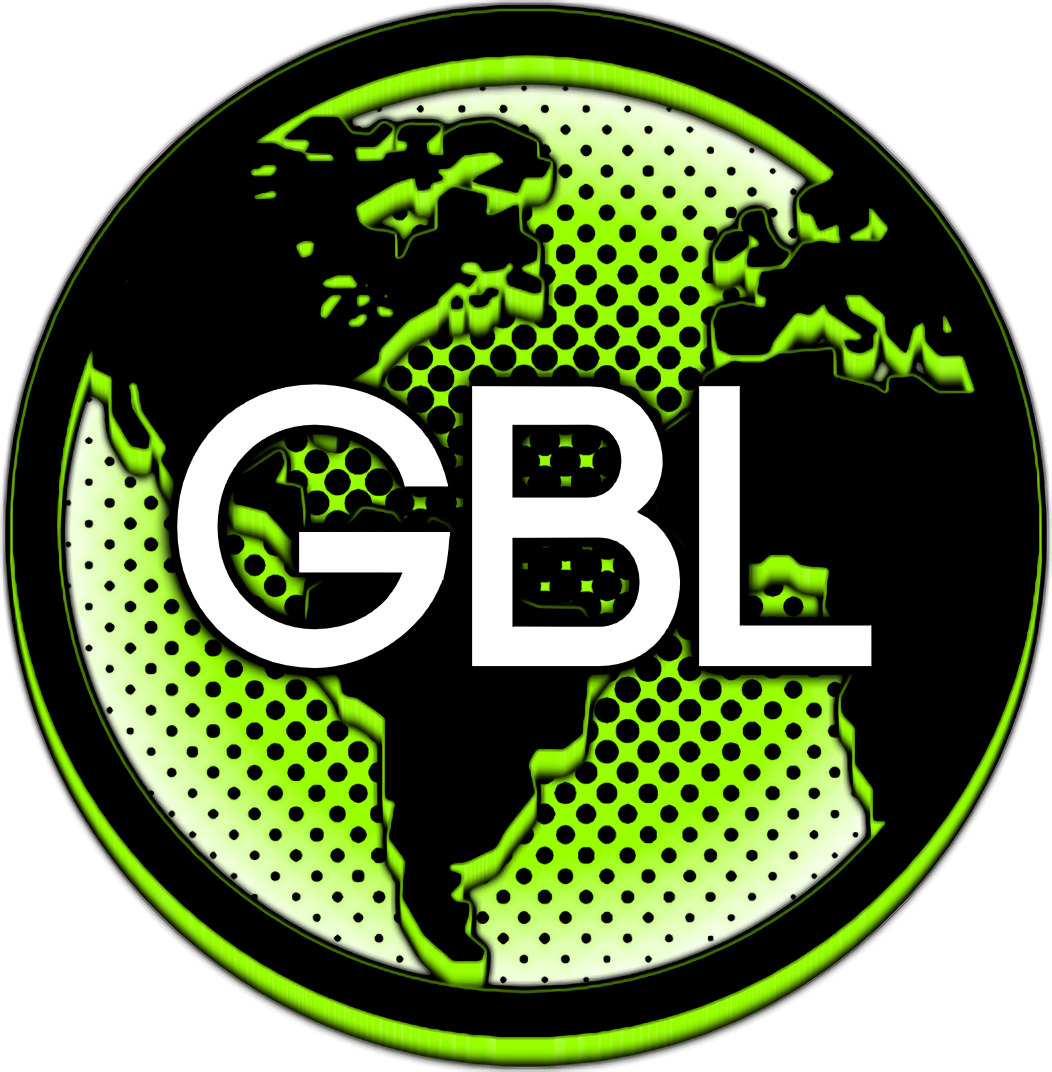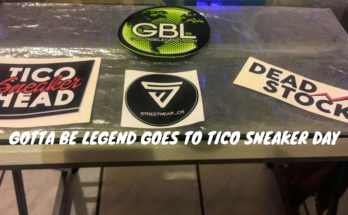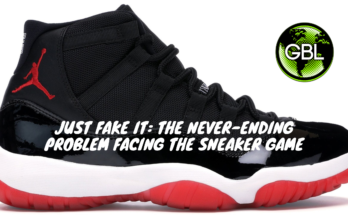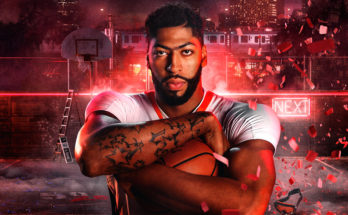You already know how it ended, but do you know how it started?
Tonight, the 10-part docuseries covering the Michael Jordan-led Chicago Bulls ended. Many of us were around when the ‘Air Jordan’ phenomenon started and took off. Some saw it from the beginning when Jordan first took the court for the University of North Carolina’s men’s basketball team. Others started to pay attention during his NBA rookie year in 1984. Those in Chicago certainly did. This ‘Guard’ from North Carolina was starting to help sellout the old Chicago Stadium. The Bulls, a team full of mediocrity, was an afterthought in Chicago before 1984. With historic franchises like the Cubs, the White Sox, the Bears, and the Blackhawks, there wasn’t enough time to follow the Bulls. That all changed during the 1984 NBA season, and this is where The Last Dance starts.
Pre-Chicago Bulls
With a 27-55 regular-season record in 1983, the Chicago Bulls were poised to pick third in the 1984 NBA Draft. The first two picks were for the Houston Rockets and the Portland Trailblazers, respectively. Before the draft, it was well known that Houston would take Nigerian prospect, Akeem Olajuwon, with the first pick. Portland, however, opted to pick Kentucky Wildcat Sam Bowie second. This set the stage for Chicago to take North Carolina Tar Heel, Michael Jordan, with the third pick. Previously attending UNC for 3 seasons, it was Tar Heel Head Coach, Dean Smith, that advised Jordan to enter the NBA Draft after his Junior year. Jordan found a lot of success at North Carolina, winning the NCAA Championship as a Freshman in 1982.

You may have seen the footage before. It was against Patrick Ewing’s Georgetown Hoyas, where Jordan (then referred to as Mike Jordan) hit the game-winning shot from the left-wing, serving as a catalyst to his future success. As a Tar Heel, Jordan had a fantastic collegiate career. He averaged 17.7 PPG, 54% shooting from the field while averaging 5.0 RPG. He was selected to the NCAA All-American First Team in both his Sophmore and Junior year. Jordan also won the Naismith and the Wooden College Player of the Year awards his Junior year. With this much success, it was only right that Dean Smith advised Jordan to enter the NBA Draft since he’d likely be a high lottery pick.

The early years
It wasn’t easy being a Chicago Bull for Jordan during the first few years of his career. In 1984, he made the NBA All-Star team, led his team to a playoff birth against the Milwaukee Bucks, and won the NBA Rookie of the Year Award. The following season, his season was almost lost due to a broken foot. However, Jordan was able to make it back on-time to lead his team into the playoffs for the second consecutive year.

Thought to have been a lost season, Jordan was able to will his team to an 8th seed playoff birth. Bulls’ management wasn’t very eager to reach the playoffs, but Jordan wasn’t going to quit on his team. Chicago’s front office was aiming at a lottery pick that season, as they didn’t expect Jordan would return to the court that year. Unknowingly for management, Jordan went back to UNC and was rehabbing his injury in secret.

MJ made it back in time and was poised to face the mighty Boston Celtics in the first round of the 1986 NBA playoffs. Inexperienced compared to the veteran Celtics, Jordan’s Bulls were swept, not before setting a still unbroken record of 63 points in Game 2 at the legendary Boston Garden. The following season, Jordan had one of the most prolific scoring seasons in NBA history. He averaged 31.7 PPG and led his team to the playoffs for the third consecutive year. Unfortunately for the Bulls, they ran into the Celtics and were swept once again.
The Chicago Bulls trade for Scottie Pippen
Chicago’s front office had been engaged in heavy scouting of a young prospect from Arkansas. He was tall, had great passing skills, and was aggressive on both sides of the court. It was NBA Draft night in 1987, and with the fifth pick, the Seattle SuperSonics drafted Scottie Pippen from the University of Central Arkansas. However, there was already an agreement in place with the Chicago Bulls. It was agreed that Seattle would draft Pippen and then trade him to Chicago. Standing at 6′ 8″ and with the skills to play multiple positions, Pippen was a great building piece to put alongside their star player, Jordan. In addition to acquiring Pippen on draft night, Chicago also acquired 6′ 10″ power forward Horace Grant from Clemson University. It seemed as though the help Jordan and the Bulls needed to reach their goals were now in place.

The Bad Boys
From 1987-1990, the Bulls would face and lose to the Detroit Pistons in the playoffs. Starting in 1987, Jordan’s first MVP and Defensive Player of the Year season, the Bulls would finally get past the first round of the playoffs. However, they faced an experienced and tough team in the second round. The Pistons would prevail 4-1 against the Bulls. They were the better team after having a then-franchise record-setting season. Detroit would then lose in the NBA Finals to the Los Angeles Lakers.

In 1989, after getting past Cleveland with “The Shot” over Craig Ehlo and getting past the New York Knicks, Jordan and the Bulls would face Detroit once again. This time, they faced each other in the Eastern Conference Finals. The Pistons would prevail in six games. They would then move on to win their first NBA championship against the Los Angeles Lakers. It was the first time Detroit implemented the infamous “Jordan Rules” to prevent Jordan from scoring at will.

Enter Phil Jackson and the Triangle Offense
Coming into the 1990 season, Doug Collins has been the Bulls head coach since 1986. However, he was replaced by Tex Winter protege, Phil Jackson. Jordan was a huge fan of Collins, who would allow him to score at-will and would rely on him every time. Jackson saw this as a hindrance. He felt that if Jordan would continue to be allowed to play this way, he would never get to where he wanted to be. To reach his goal, Jordan needed to learn to trust his teammates more. Jackson would implement Winter’s system, the Triangle Offense.

This system would ensure the ball and players move around while creating openings and opportunities for all players to score. Chicago would win 55 games during the 1989-1990 NBA season using this new system. It allowed Jordan to create opportunities for his teammates while also lowering his player usage. However, he would remain the number one option on the team.
After getting past the Milwaukee Bucks and the Philadelphia 76ers, the stage was set for a third encounter against the Pistons. It was a hard-fought series with more “Jordan Rules” activity. The series would go seven games, but Chicago would come up short again. They lost on the road and the outcome could’ve been different had Scottie Pippen not been suffering from a migraine that day. Detroit would then face the Portland Trailblazers in the NBA Finals. They would win in five games and win their second consecutive NBA championship. After losing to Detroit, Jordan knew he had to get stronger to get past them. The amount of punishment he was taking due to the “Jordan Rules” was preventing him from scoring at-will and getting over the hump. It was time for Jordan and the Bulls to bulk-up.
The first championship
The Bulls were thumping at the door, battling the best for Eastern Conference supremacy. For the past three seasons, they would fall short to Detroit. Knowing what needed to be done to eclipse them, Chicago was determined to get stronger as they prepared for the 1990-91 NBA season. The hard work paid off, as the Bulls would boast the best record in the Eastern Conference at 61-21. Jordan would go on to win his second NBA MVP award and lead the Bulls past the New York Knicks and the Philadelphia 76ers in the first two rounds of the 1991 NBA playoffs.
This would lead to a much-anticipated rematch against the defending champion Detroit Pistons in the Eastern Conference Finals.
Chicago had played their way to a top seed in the playoffs and worked all offseason for this showdown. They knew they were bound to face Detroit once again and that they had to get past this hump once and for all. They did. Dominantly, too. The Bulls would end up sweeping the Pistons in the Eastern Conference Finals, causing them to walk off the court before the game was over. The Bulls were finally on their way to the NBA Finals, getting rid of an old rival once and for all.
They would face the Los Angeles Lakers there, and although they lost the first game, they would dominate the rest of the series 4-1 and win their first NBA championship. Jordan would also go on to win his first NBA Finals MVP award. They’d finally arrive at the top of the mountain, and their reign was just beginning.

Back-to-back
The following season, the Bulls would continue to impose their will on the rest of the league. They would top their then-franchise record-setting win total by going 67-15 in the regular season. Jordan would go on to win his second consecutive and third overall NBA MVP award. Simply put, the Bulls were a class above the rest. They would get past the Miami Heat, New York Knicks, and Cleveland Cavaliers in the Eastern Conference playoffs to reach the 1992 NBA Finals.
There, they would meet the top-seeded Western Conference champions, the Portland Trailblazers.
The matchup would be touted by the media as Jordan vs. Drexler, but Jordan knew there wasn’t any comparison there. It showed, especially in Game 1 where MJ would score 35 points in the first half, hitting six three-point field goals in the process. Jordan and the Bulls were too much for Portland. They would win their second consecutive NBA championship in 6 games and Jordan would once again be named NBA Finals MVP.
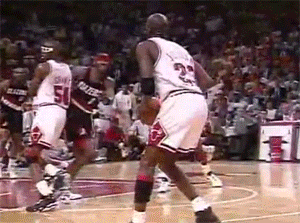
Three-peat
In 1993, the Bulls would continue to prove they were the best team in the NBA. Although they weren’t as dominant in the regular season as they were the year before, they were dominant when it mattered the most. In the playoffs, they would make easy work of the Atlanta Hawks and Cleveland Cavaliers. However, they would be matched up with a new rival. One that took them to seven games the year before. The top-seeded, New York Knicks.
The Bulls would end up winning the series in six games, but the turning point of the series was Game 5. Better known as “The Charles Smith Game”. A moment that would forever live in Knicks-fans nightmares.
Back in the NBA Finals for the third consecutive year, the Bulls would face the Phoenix Suns and NBA MVP Charles Barkley. Yes, that’s correct. Jordan would lose his chance at a third consecutive NBA MVP award. He would win the one that mattered the most: The NBA Finals MVP. Chicago would beat Phoenix in six games. They would become the first team to three-peat since the Bill Russell led Boston Celtics of the 1960s. A goal Jordan was determined to reach. One that his peers, Magic Johnson and Larry Bird, never accomplished. A new dynasty was born with a new king sitting atop the throne.

A tragedy leads to retirement
Shortly after capturing their third consecutive NBA championship, the Bulls’ reign atop the NBA would be halted. During the summer, James Jordan, father of their superstar player Michael Jordan, was murdered. It was determined that Mr. Jordan was a victim of a carjacking that went wrong. The news of his passing devastated Michael and his family. He was very close to his father, describing him as his “best friend”. Mr. & Mrs. Jordan had been alongside Michael throughout his entire life, watching him grow into the man and superstar he’d become. Yet still, he was always their little boy in their eyes. Mr. Jordan was always there for Michael, supporting his son through all his failures and achievements. Michael wanted his last game in the NBA to be the last game his father ever saw him play.
Therefore, on October 6, 1993, at age 33, Michael Jordan announced his retirement from the game of basketball.

A diamond helps fulfill a wish
It wasn’t long after announcing his retirement from basketball that Jordan would make headlines again. On February 7, 1994, Michael Jordan announced that he had signed a Minor League Baseball contract with the Chicago White Sox. Fortunately for him, Jerry Reinsdorf, the owner of the Chicago Bulls, was also the owner of the Chicago White Sox. This facilitated Jordan’s transition to fulfilling a wish his father always had for him. As a child, Jordan loved playing baseball. He always loved the sport and his father knew that. Mr. Jordan wanted Michael to play baseball professionally and it was something they discussed before his passing. After the tragedy of his father’s murder, Michael knew it was time to make his father’s wish come true. Jordan was now a member of Double-A Chicago White Sox affiliate, the Birmingham Barons.

A strike leads to a surprise
Unbeknowestingly to Jordan and the Bulls, a player’s strike in Major League Baseball would catalyze a surprise announcement. It was August 12, 1994, when the player’s strike would go into effect. Jordan was still a baseball player at the time. MLB was planning to continue the season with replacement players. Jordan, still being a Minor Leaguer, refused to play against anyone that wasn’t considered the same.
With more free time on his hands than expected, Jordan found himself back in basketball circles. He reached out to former teammate B.J. Armstrong to meet up for breakfast and before he knew it, he was back practicing with his old teammates at the Bulls practice facility. During Jordan’s departure from basketball, the Bulls would enjoy some success, particularly during the 1993-94 season. They would make the playoffs, Scottie Pippen would put up All-NBA numbers and Toni Kukoc would become a revelation. The Bulls would win 55 games that year, two less than they did with Jordan the year before. Unfortunately, the chance for a fourth consecutive championship didn’t happen. The Bulls would lose to the New York Knicks 4-3 in the Eastern Conference Semifinals. The following season, 1994-95, the Bulls would struggle. The rest of the NBA had gotten better and gotten out of Jordan’s and the Bulls’ shadow.

The Bulls remained competitive and were in the midst of making the playoffs, but it wasn’t going to be easy this time around. Luckily for them, the player’s strike in baseball would work to their benefit, and Jordan was slowly working on a comeback to basketball.

“I’m back.”
It was March 18, 1995, and the word was out. Michael Jordan was returning to basketball and the Chicago Bulls. Right on time to make a playoff push, which they did. With just 17 games left in the 1994-95 season, the Bulls would go 13-4 with Jordan on the team. It took some time for him to get used to playing at a high level again, and it took time for everyone to get used to his new number, too. Jordan had been back in the NBA for precisely two months when the Bulls would be eliminated from the playoffs against the Orlando Magic in the Eastern Conference Semifinals. However, before the end of the series, he would be scolded about his new jersey number, leading Jordan to return to his patented #23.

72-10
After being eliminated from the 1995 NBA playoffs, Jordan and the Bulls would embark on a mission to regain supremacy in the NBA. They would do so in record-setting fashion. The 1995-96 Chicago Bulls would not only include Michael Jordan at full capacity, but they would also go 72-10 in the regular season. At the time, it was the greatest regular-season record in NBA history. The Bulls would be on a tear this year, looking to get back to where they once were. New faces arrived, most notably, Dennis Rodman. The former ‘Bad Boy’ was now a Bull, and he was as integral as management thought he’d be.
With a supporting cast that included All-Star forward Scottie Pippen, Jordan would now have a full season to play alongside European star Toni Kukoc, a player Jordan and Pippen had initially set their eyes upon back at the 1992 Barcelona Summer Olympics. There was a lot of animosity between them back then, with Jordan and Pippen wanting to send the Croatian star a ‘clear message’ that he wasn’t on their level.
As the season rolled on, the Bulls would go on to prove that nobody, as a unit, was on their level. Jordan would go on to win his fourth NBA MVP award and the Bulls would make easy work of their Eastern Conference foes on their way to the 1996 NBA Finals. There, they would meet the Seattle SuperSonics and in storybook fashion, they would win in six games, clinching in Chicago on Father’s Day. Jordan, of course, would once again be named NBA Finals MVP. The images of Jordan hugging the game ball, laying face down on the floor and crying symbolize the return atop of the throne after an emotional departure.

Back-to-back, again.
For the 1996-97 NBA season, the Bulls would continue where they left off. They dominated the league as the NBA celebrated its 50th Anniversary. Jordan and Pippen would be named as part of the 50 Greatest Players in NBA history that year. The Bulls would go 69-13, once again be a top-seed in the Eastern Conference and make light work of their opponents as they returned to the NBA Finals. Jordan, however, would lose out to Utah Jazz forward Karl Malone for the NBA MVP award, and it was only fitting that their teams would meet at the 1997 NBA Finals. The Bulls would show their superiority and experience against the Jazz, winning their fifth and second consecutive NBA championship in six games.
Once again, Jordan would outshine the league MVP on the grandest stage, just like he did against Charles Barkley in 1993. The series is best remembered for Jordan’s performance in Game 5 at Utah, where he was battling “flu-like symptoms”. At the time, there wasn’t any indication that it could be food poisoning instead. However, it was later revealed that it indeed was food poisoning that affected Jordan for Game 5. Nonetheless, we got one of the greatest performances in NBA Finals history with Jordan’s “Flu Game”.

“The Last Dance”
It had become clear before the 1997-98 season by Bulls management that this would be Phil Jackson’s last season as head coach. The front office felt that the majority of their players were heading into the latter part of their careers. They thought that it’d be wise to start rebuilding soon. Jerry Krause, general manager of the Chicago Bulls since 1985 helped mastermind the franchise’s success. He was adamant that it was time to move on and informed owner Jerry Reinsdorf that this was the direction he wanted to take. He received the support of the owner and was vocal about how this would be the final season for Jackson.
These actions led to a greater disdain of the front office by the player personnel. It was no secret that many key members of the Chicago Bulls basketball team disliked Jerry Krause. Although they all gave him credit for assembling the team, the players felt that the success of the franchise was mostly due to the blood, sweat, and tears they endured on their journey. They felt undermined and unappreciated, both economically and emotionally. This all led to a roller-coaster ride of a season.
Jordan had already publicly stated that he would not be part of a rebuild. He also publicly stated that he would not play for anyone other than Phil Jackson. He was firm with his decision and the rest of his teammates supported him and their head coach. It was thought that if Jackson was in his final year, the rest of the team would also come apart. There were rumblings that if Jackson were no longer to be part of the organization, Jordan would leave the Bulls and retire from basketball.
In the midst of all this, there were also issues going on with Pippen. A lingering ankle injury Pippen refused to treat during the offseason caused him to miss almost half of the regular season. He felt that he was being snubbed monetarily even after the league’s massive economic growth. Pippen was one of the most underpaid All-Stars in the NBA. He felt that by opting to postpone his surgery until the start of the season, he’d be ‘sticking it to the man’. He would also demand a trade to spite the front office.
Eventually, things would come together for the Bulls. Pippen returned to the team. Rodman would return from his unusual mid-season ‘vacation’. Jackson and Jordan would be there to lead the way. They would win 62 games that season, clinching the top seed in the Eastern Conference. Jordan would win his fifth and final NBA MVP award. They would easily get past the New Jersey Nets and Charlotte Hornets in the first two rounds of the 1998 NBA playoffs. However, they would have their hands full against the Indiana Pacers in the Eastern Conference Finals. The Pacers took the Bulls to seven games. The first time since 1992. The Bulls would prevail and return to the NBA Finals to face off against the Utah Jazz in a rematch of last year’s final.
In true ‘Jordanesque’ fashion, the Bulls would defeat the Jazz in six games to win their sixth and third consecutive NBA championship. Jordan would once again win the NBA Finals MVP. It was the second three-peat for Jordan and the Bulls, a feat that hasn’t been done since. It also defined the end of an era, as this was the last time the band would play together. A remarkable run led by Jordan, who had been there since the beginning when the Bulls where merely an afterthought. He would never play another game for Chicago as he retired again on January 13, 1999.
Thus, we’re left with “The Last Shot” from “The Last Dance”.

You can watch The Last Dance, a 10-part documentary series on Michael Jordan and the Chicago Bulls on Netflix. Directed by Jason Hehir. Co-produced by ESPN Films and Netflix.
